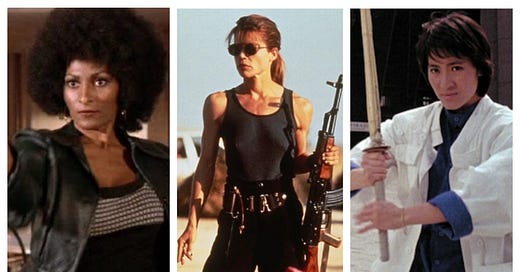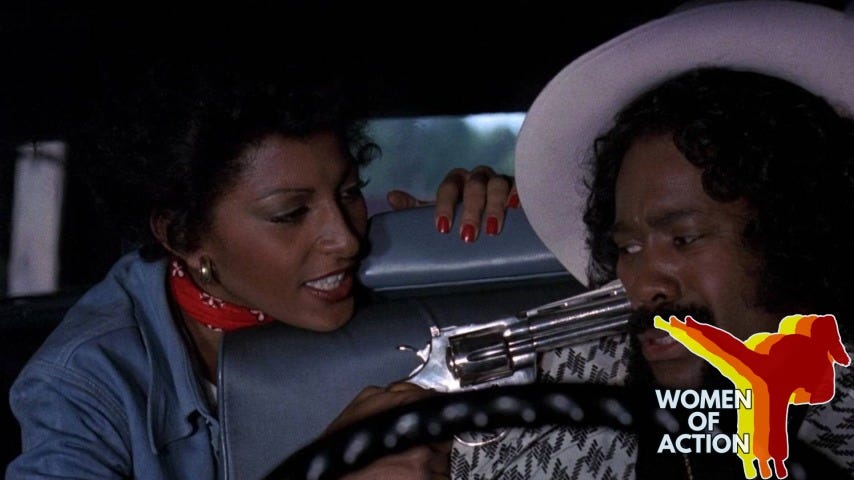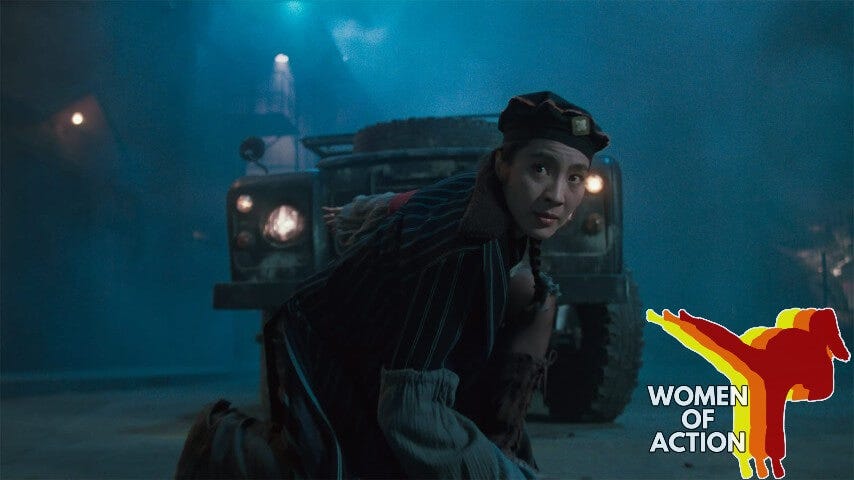The women who made action movie history
Celebrating Pam Grier, Michelle Yeoh, Linda Hamilton, and more
Welcome to Girl Culture, the newsletter where Caroline Siede examines pop culture, feminism, and more. You can learn about Girl Culture’s mission here and support here.
When I’m not writing about girl culture here, I’m writing about female-driven action movies for my monthly A.V. Club column Women of Action. The column jumps around in time to offer deep dives into movies and performers who shaped what we think of as “strong female characters.” And I wanted to highlight three installments that I’m particularly proud of. So consider this a crash course in a trio of trailblazing female action stars.
Pam Grier as a 1970s blaxploitation icon
“Wham! Bam! Here comes Pam!” Thus reads the tagline of Pam Grier’s 1975 film Friday Foster, the final in her illustrious line of 1970s Blaxploitation films. If one way to know you’ve made it is by achieving first-name-only status, then Grier had certainly arrived. With no disrespect to Richard Roundtree, I think it’s fair to say that while Shaft is the defining character of the Blaxploitation era, Grier is the defining actor of the genre.
In an era where white men dominated Hollywood and Black men dominated the burgeoning Blaxploitation canon, Grier forged her own path playing the title roles in 1973’s Coffy, 1974’s Foxy Brown, and 1975’s Sheba, Baby. She was a trailblazer for Black women and one of the first female action heroes in Hollywood. And even if you’ve never seen a Grier Blaxploitation film, you’ve likely felt their influence somewhere—from Beyoncé in Austin Powers In Goldmember to Quentin Tarantino’s loving homage Jackie Brown to the Marvel Comics heroine Misty Knight.
Grier’s gift as an actor is her ability to combine girlish sweetness with a tough, brassy sense of strength. She can sweet talk a bad guy one minute and cut him down with a razor blade she hid in her afro the next. Her starring Blaxploitation roles combine over-the-top dialogue, stunning costumes, and heaps of sex and violence into an unforgettable package. Yet in the rush to praise Grier as the badass she is, we can also risk repackaging her ’70s legacy into something much simpler and more straightforward than it actually was. That does a disservice not only to Grier, but to the complex roles she played on screen.
In fact, part of the reason that female action heroes didn’t really emerge until this permissive post-Hays Code era is because that’s when Hollywood realized it could sell female action heroes as risqué sexual fantasies for men. Though studios have always been happy to offer male power fantasies to male audiences, they couldn’t conceive of a female power fantasy until they figured out how to aim it at 19-year-old boys (a line of thinking that, frankly, continues right on through to today). And while Grier herself has said she was comfortable doing nude scenes and enjoyed getting to celebrate “Black female feminine sexuality,” it’s always worth keeping in mind that male action stars seldom need to (literally) expose themselves in the same way to get work. [Read more]
Michelle Yeoh as a 1980s Hong Kong action star
Before launching her Hollywood career with 1997’s Tomorrow Never Dies, Michelle Yeoh appeared in 18 films over 13 years in Hong Kong, trying her hand at just about every subgenre of the region’s action filmmaking in the process and even inventing a few new ones too. […] “When I started off in 1984, women were relegated to being the damsel in distress,” Yeoh told People. “We need to be protected, according to our guys. But then I would go, ‘No, guys, I think we can protect ourselves pretty well. And if push comes to shove, maybe I can protect you too.’” Thanks to some encouragement from a producer’s wife, D&B gave her that chance a year later in her first starring role: Yes, Madam, a buddy cop thriller that also doubled as the first acting vehicle for American martial arts star Cynthia Rothrock, who’d go on to have her own impressive run in Hong Kong action movies.
Yeoh trained eight hours a day in a stunt gym to get in fighting shape and the work paid off. Yes, Madam was an immediate hit and quickly kicked off a new “girls with guns” trend in Hong Kong action cinema: movies about tough female leads (often cops) who engage in shootouts in between beating up baddies with their martial arts skills. Though the movie as a whole is pretty unbalanced, with way too much time spent on its bumbling male supporting cast, Yeoh and Rothrock are absolutely electric in their action scenes together. It’s impossible not to cheer when they cockily low-five before taking on an army of goons. And Yeoh would get an even better “girls with guns” vehicle the next year with Royal Warriors, a police revenge thriller co-starring a young Hiroyuki Sanada and featuring an all-time great airplane fight.
Both roles showcase Yeoh’s knack for combining brutal action with playful fun. She knows just when to punctuate a movement with the hint of a smile, and her dramatic acting chops are put to great use in Royal Warriors too, which takes some pretty brutal twists and turns in between its high-octane fights. It’s also really striking how much these movies allow their female leads to get the absolute shit kicked out of them by men—something Hollywood films often shy away from by giving female heroes female villains to fight. In Hong Kong, there’s a refreshing sense that female fighters really are just “one of the boys.” [Read more]
Linda Hamilton as Sarah Connor in The Terminator franchise
Despite all the cool ideas packed into the first film, Sarah Connor wasn’t really thought of as a true action heroine until she got a buff movie makeover seven years later in Terminator 2: Judgment Day. Just weeks after giving birth to her first child, Linda Hamilton began a months-long fitness regimen that included weight lifting, fat loss, and intensive weapons and military training with a former Israeli special forces soldier. Watching Hamilton’s sinewy arms lift her into frame in T2 is as impressive a physical transformation as anyone has ever delivered in cinema history, and has long earned her praise for being a “badass” or an “icon” for strong female characters. But, as in the first film, Sarah’s arc is far more complicated than just beat-‘em-up wish fulfillment.
In fact, when director James Cameron (fresh off giving Ripley a mech suit in 1986’s Aliens) called up Hamilton to see if she’d be interested in coming back for a Terminator sequel, she had one request: “I want to be crazy.” Hamilton instinctively knew there was no way Sarah could experience everything she did in the first film and not come away utterly changed by shell shock, grief (her best friend and her mother are both murdered by the Terminator), and the weight of knowing humanity’s end date. Terminator 2 needed to have an emotional continuity as airtight as the franchise’s clever closed-loop time travel. And what pop culture celebrations of Sarah’s badass makeover sometimes miss is that she’s not really an aspirational portrait of strength so much as a woman who’s spent 10 years existing in a non-stop trauma response. As Hamilton put it, “Sarah Connor is not an icon. She’s a woman in hell.”
Much like the first film, T2 anchors Sarah’s arc in fears that are relatable to everyday women: the fear of not being believed, of being institutionalized, of being sexually harassed by men who have power over you, of not being able to protect your child, of letting existential fears strip you of your humanity. If the first Terminator challenges the fallacy of learned helplessness, T2 explores another unhealthy coping mechanism so many women rely on: hyper-independence. Faced with the knowledge that the future of humanity rests on her ability to protect and train her son, Sarah has closed herself off from emotional vulnerability, even though, ironically, that’s the very thing her kid wants most from her. “I didn’t need your help,” she coldly tells John (Edward Furlong). “I can take care of myself.” [Read more]
I’ve also written about Jennifer Lopez in Enough, the 2017 Wonder Woman movie, Disney’s animated Mulan, and Charlize Theron’s stylish flop Æon Flux. New columns drop each month over at The A.V. Club!







